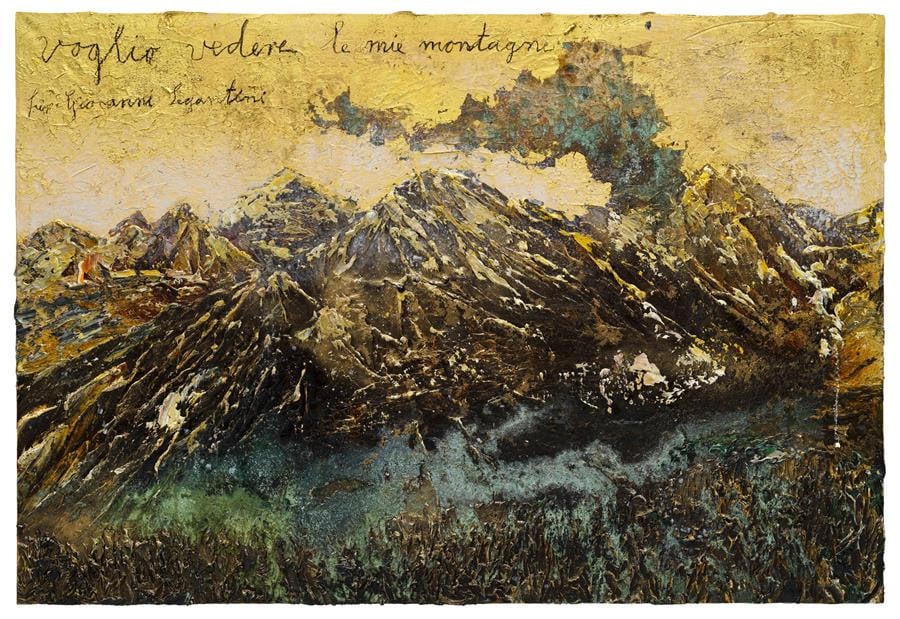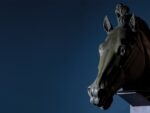Anselm Kiefer – Voglio vedere le mie montagne für Giovanni Segantini

Voglio vedere le mie montagne – für Giovanni Segantini, la nuova mostra personale di Anselm Kiefer, che segna il ritorno dell’artista in città.
Comunicato stampa
Domenica 12 febbraio 2023 la Galleria Lia Rumma di Napoli inaugura: Voglio vedere le mie montagne - für Giovanni Segantini, la nuova mostra personale di Anselm Kiefer, che segna il ritorno dell’artista in città.
Il titolo della nuova serie di dipinti presentati in mostra, ripreso dalle parole pronunciate dall’artista Giovanni Segantini poco prima di morire, rimanda anche ad un’opera di Joseph Beuys, che Kiefer incontra negli anni di formazione all’Accademia di Düsseldorf. Ma per Kiefer: "Il titolo spesso non è la spiegazione dell'immagine, ma è piuttosto un’allusione". Al pari di molte altre sue opere, ispirate a versi di poeti amati, a mitologie e leggende di ogni cultura e latitudine, e perciò ricche di suggestioni e risonanze liriche ed epiche, in questo caso l’artista dà vita ad un poetico e struggente paesaggio di cime e di vette che trascendono quelle tanto amate dal pittore simbolista Segantini. Catene montuose viste come luoghi ideali ma anche minacciosi, testimoni di una natura turbolenta e in continuo movimento, dipinta a sensazione per stratificazioni di colore e umore. Per Kiefer, che procede come un vate-alchimista alla continua ricerca di nuove forme da contrapporre all’esistente, cercando così di ridisegnare ogni volta un nuovo ordine del mondo, l’atto creativo è sempre un processo in trasformazione, un non finito su cui ritornare. Più che le “montagne” dipinte da Segantini, è importante quello che si svolge tra loro o al di fuori delle tele perché, come racconta l’artista tedesco: “L’arte è come un percorso sulla cresta di una montagna, si può cadere a ogni istante da una parte o dall’altra”.
Nelle grandi tele esposte negli spazi della galleria viene rappresentato un potente e spiazzante paesaggio. Sulla superficie pittorica Kiefer si avvale della scrittura quale “parola poetica” che si muove libera – in questo caso spesso ricorre e si rincorre Voglio vedere le mie montagne - für Giovanni Segantini – al di sopra delle vette scure e terrose, colpite da una luce crepuscolare o notturna. Ma la scrittura, sempre di suo pugno, svolge una funzione ambigua offrendo dell’immagine una chiave di lettura a volte inattesa, come nel caso di Die Windsbraut (La sposa del vento), che riporta su di un paesaggio roccioso spazzato dal vento il titolo di un quadro famoso di Oskar Kokoschka che raffigura l’artista abbracciato alla sua amata Alma Mahler, come travolti da una burrasca. Un’opera creata probabilmente dopo un viaggio verso Napoli, nell’aprile 1913, quando la coppia fu sorpresa da una violenta tempesta.
Anselm Kiefer. Nato nel 1945 a Donaueschingen, dal 2007 Anselm Kiefer vive e lavora in Francia, a Parigi e a Croissy. Dopo gli studi in legge e lingue e letterature romanze, si è dedicato interamente all’arte. Ha frequentato l’Accademia di Belle Arti a Fribourg-im-Brisgau, poi a Karlsuhe, mantenendosi sempre in contatto con Joseph Beuys. Le opere di Kiefer sono state esposte e collezionate nei più importanti musei del mondo. Nel 2004 ha realizzato I Sette Palazzi Celesti, la sua prima opera permanente in Italia, all’Hangar Bicocca di Milano, progetto curato da Lia Rumma. Nel 2007 è diventato il primo artista a cui il Louvre ha commissionato un’opera permanente. Lo stesso anno, ha inaugurato Monumenta, la serie di mostre del Grand Palais a Parigi, con installazioni in omaggio ai poeti Paul Celan e Ingeborg Bachmann. Kiefer ha ricevuto il Praemium Imperiale a Tokyo nel 1999 e nel 2008 il Peace Prize of the German Book Trade. Nel 2010 gli è stata assegnata la Cattedra di Creazione Artistica nel prestigioso Collège de France a Parigi, dove ha tenuto le 9 lezioni intitolate: L’arte sopravviverà alle sue rovine. Nel 2014 la Royal Academy di Londra ha dedicato a Kiefer la sua prima retrospettiva nel Regno Unito. Nel 2015 la Bibliothèque Nationale de France e il Centre Pompidou hanno presentato una grande retrospettiva dei suoi libri, dipinti e installazioni. Nel 2022 è allestita all'interno della Sala dello Scrutinio del Palazzo Ducale di Venezia l’installazione Questi scritti, quando verranno bruciati, daranno finalmente un po’ di luce, un ciclo di dipinti ispirati ai versi del poeta veneziano Andrea Emo.
The Lia Rumma Gallery is delighted to announce the opening of Anselm Kiefer's new solo exhibition Voglio vedere le mie montagne - für Giovanni Segantini on Sunday 12 February 2023, marking the artist's return to Naples.
The title of the new series of paintings presented at the exhibition, which draws on the words uttered by the artist Giovanni Segantini shortly before his death, also refers to a work by Joseph Beuys whom Kiefer met while studying at the Dusseldorf Academy of Arts (Kuntsakademie). However, Kiefer states that "the title is often not an explanation of the image but rather an allusion". Like many of his other works, inspired by verses of his favourite poets, the myths and legends of many different cultures and places, and thus full of lyrical and epic influences and echoes, the artist in this case creates a moving, poetic landscape of peaks and mountain tops that transcend those adored by the symbolist painter Segantini. Mountain chains are viewed as ideal yet threatening places, testifying to the turbulence of the ever-changing natural world in which painting is based on sensation, using a stratification of colour and mood. According to Kiefer, who conducts himself as an alchemist-poet constantly in search of new forms to set against the status quo, trying to redesign a new order in the world, the creative act always remains a continuous process of transformation, an unfinished undertaking to which one can return. Even more than the "mountains" painted by Segantini, the crux lies in what takes place between them or outside the paintings because, as Kiefer explains, "art is like a walk along a mountain ridge where there is a risk of falling down either one side or the other”.
The large paintings on display in the gallery portray a powerful, unsettling landscape. Kiefer employs writing as a 'poetic word' on the picture surface that moves freely - in this case the words Voglio vedere le mie montagne - für Giovanni Segantini return and chase each other - above the dark, earthy peaks, illuminated by crepuscular or nocturnal rays of light. But the writing, always done in his own hand, has an ambiguous function, providing the image with an occasionally unexpected interpretation, as in the case of Die Windsbraut (The Bride of the Wind) where a rocky windswept landscape is overlain by the title of a famous painting by Oskar Kokoschka which depicts the artist embracing his lover Alma Mahler as if they had been swept away by a storm. The idea for the work probably came to him following a trip to Naples in April 1913 when the couple were caught by surprise by a sudden, violent storm.
Anselm Kiefer. Born in 1945 in Donaueschingen, Anselm Kiefer has been working in Paris and Croissy since 2007. After studying law, and Romance languages and literature, he devoted himself entirely to painting. He attended the School of Fine Arts at Fribourg-im-Brisgau then the Art Academy in Karlsuhe while maintaining a contact with Joseph Beuys. Kiefer’s work has been collected by and shown at major museums throughout the world. In 2004 Kiefer realized The Seven Heavenly Palaces the first permanent installation in Italy, at Hangar Bicocca in Milan, curated by Lia Rumma. In 2007, he became the first artist to be commissioned to install a permanent work at the Louvre. The same year, he inaugurated the Monumenta exhibitions series at the Grand Palais in Paris, with works paying special tribute to the poets Paul Celan and Ingeborg Bachmann. Anselm Kiefer was awarded the Praemium Imperiale Prize in Tokyo in 1999, and in 2008 received the Peace Prize of the German Book Trade. In 2010 Anselm Kiefer was appointed to the Chair of Artistic Creation at the renowned Collège de France in Paris, where he delivered nine lectures entitled Art will survive its ruins. In 2014, the Royal Academy of Arts in London presented his first retrospective to be held in the UK. In 2015 the Bibliothèque Nationale de France and the Centre Pompidou in Paris showed major retrospectives of his artist books, paintings and installations. In 2022 the installation Questi scritti, quando verranno bruciati, daranno finalmente un po’ di luce, inspired by the verses of the Venetian poet Andrea Emo, was set up in the Sala dello Scrutinio of the Doge’s Palace in Venice.



